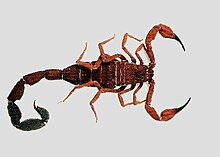Bactridine
| Bactridin-1 | ||
|---|---|---|
| Andere Namen |
P-Arthr-Antm-beta* NaTx2.6 | |
| Masse/Länge Primärstruktur | 61 Aminosäuren, 6.928 Da | |
| Bezeichner | ||
| Externe IDs | ||
| Bactridin-2 | ||
|---|---|---|
| Andere Namen |
P-Mice-Antm-beta* NaTx14.8 | |
| Masse/Länge Primärstruktur | 64 Aminosäuren, 7.374 Da | |
| Bezeichner | ||
| Externe IDs | ||
Bactridine sind eine Gruppe von Toxinen im Gift des Dickschwanzskorpions Tityus discrepans.

Eigenschaften
[Bearbeiten | Quelltext bearbeiten]Bactridine umfassen sechs Peptide. Sie binden an spannungsgesteuerte Natriumkanäle,[1] ungewöhnlicherweise sowohl an die von Bakterien als auch von Eukaryoten.[2] Bei Bakterien wird dadurch ein antibakterieller Effekt erzielt,[1] während die Bactridine in Eukaryoten zur Vergiftung der Beute und zur Abwehr von Fraßfeinden dienen. Im Menschen erzeugen Bactridine ein Ödem in der Lunge.[3]
Bactridine gehören zu den längeren Skorpiontoxinen mit vier Disulfidbrücken.[4] Sie (Bactridine 1–6) besitzen die Molmassen 6916, 7362, 7226, 7011, 7101 und 7173 Da. Es existiert ein Antitoxin, das aus polyklonalen Antikörpern gegen die Bactridine besteht.[5][6]
Einzelnachweise
[Bearbeiten | Quelltext bearbeiten]- ↑ a b P. Díaz, G. D'Suze, V. Salazar, C. Sevcik, J. D. Shannon, N. E. Sherman, J. W. Fox: Antibacterial activity of six novel peptides from Tityus discrepans scorpion venom. A fluorescent probe study of microbial membrane Na+ permeability changes. In: Toxicon : official journal of the International Society on Toxinology. Band 54, Nummer 6, November 2009, S. 802–817, doi:10.1016/j.toxicon.2009.06.014, PMID 19540868.
- ↑ P. Forsyth, C. Sevcik, R. Martínez, C. Castillo, G. D'Suze: Bactridine's effects on DUM cricket neurons under voltage clamp conditions. In: Journal of insect physiology. Band 58, Nummer 12, Dezember 2012, S. 1676–1685, doi:10.1016/j.jinsphys.2012.10.009, PMID 23085555.
- ↑ J. Brazón, C. E. Hughes, J. Mori, C. Sevcik, G. D'suze, S. P. Watson: Tityus discrepans scorpion venom activates platelets through GPVI and a novel Src-dependent signaling pathway. In: Platelets. Band 22, Nummer 3, 2011, S. 165–172, doi:10.3109/09537104.2010.544343, PMID 21322750.
- ↑ Steve Peigneur, Carlos Sevcik u. a.: Subtype specificity interaction of bactridines with mammalian, insect and bacterial sodium channels under voltage clamp conditions. In: FEBS Journal. 279, 2012, S. 4025–4038, doi:10.1111/j.1742-4658.2012.08808.x.
- ↑ A. Borges, R. G. Tsushima, P. H. Backx: Antibodies against Tityus discrepans venom do not abolish the effect of Tityus serrulatus venom on the rat sodium and potassium channels. In: Toxicon : official journal of the International Society on Toxinology. Band 37, Nummer 6, Juni 1999, S. 867–881, doi:10.1016/S0041-0101(98)00201-3, PMID 10340827.
- ↑ P. Díaz, G. D'Suze, C. Sevcik: Ability of horse anti-Tityus discrepans F(ab')2 ELISA assay to recognize Tityus discrepans venom toxins. In: Toxicon : official journal of the International Society on Toxinology. Band 88, September 2014, S. 88–92, doi:10.1016/j.toxicon.2014.06.003, PMID 24932739.